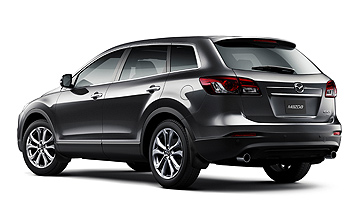BY HAITHAM RAZAGUI AND TIM NICHOLSON | 10th Dec 2012

With the gaping new grille, it bears more than a passing resemblance to Maserati Kubang unveiled at last year’s Frankfurt motor show, but still looks more like a people-mover than an SUV – and we can see the appeal in that.
But for all the exterior modernity, Mazda’s attempts to spruce up the cabin cannot hide its age.
The high-up, old-school red LED display for climate control settings and trip computer functions looks like something out of Knight Rider while the small infotainment/sat-nav screen is low down and low-res and the gear selector is still one of those stepped-gate affairs.
That said, Mazda got it right first time with the original CX-9 in terms of comfort, interior storage, logical layout and the best feeling of solidity this side of the more expensive Volkswagen Touareg. It has not messed with the successful formula here.
All three rows of seats provide ample space and comfort – with adjustable head restraints all round – and the third row has enough leg, head and foot room for even average-height adults to survive a short journey.
The centre row slides fore and aft to provide more space for rear passengers at the expense of central occupants – or vice-versa – and enable easier access to the rearmost seats.
As far as we could tell, it only has two lock-stops, with no middle-ground position available, so we can imagine a CX-9 full of children getting rowdy as the centre and rear rows argue over who gets the legroom.
Also, the rear row gets four recesses suitable for securing drinks while the centre row gets a pair of cup-holders – along with a covered storage area – in the central arm-rest, so three abreast on the centre bench means only a pair of small door bins and map pockets are available.
On the upside, there is a fair bit of space behind the rear bench and both rows of seats split-fold to provide several combinations of space for cargo and people.
For the first leg of our launch drive, we sank ourselves into the plush leather seats of the flagship Grand Touring, quickly finding an ideal driving position via the electric seat controls and fully-adjustable steering wheel.
The new keyless entry and start system still requires the driver to turn a knob where the key would normally be inserted instead of pushing a starter button, but at least the key can remain in a pocket or bag.
After luxuriating in the Grant Touring, switching to the entry-level Classic did not leave us feeling short-changed for comfort – especially considering the almost $20,000 price difference – as the fabric seats are almost as good, all the necessities are in there and there was no difference to the feeling of cabin solidity.
Heading east from Melbourne airport, the surroundings quickly become countryside and the roads get narrow, which sent the new lane departure warning system of this big, wide, US-biased SUV to into overdrive, beeping with such irritating regularity that we turned it off.
Turning it off required searching around a little panel of buttons hidden beside the driver’s right knee, which also contains the switch for disabling the electronic stability control.
Annoying driver assistance aids disabled, we were able to enjoy smooth, refined progress and the slick six-speed automatic transmission.
When the CX-9 was first launched in 2007 its dynamics were lauded against rivals like the Toyota Kluger, which like the CX-9 needs its petrol V6 engine revving to give its best and has no turbo-diesel option.
Things have moved on since then though, and now less-expensive competitors like the Kia Sorento have the CX-9 licked on body control, steering and the availability of grunty, efficient diesel engines – but the Mazda remains one of the most comfortable-riding big SUVs out there.
Unfortunately the over-assisted steering is low-geared, meaning more arm-twirling than expected is required for low-speed manoeuvres.
Big 18-inch wheels on base front-drive Classic variants and huge 20-inch wheels with fat tyres on the mid-spec Luxury and flagship Grand Touring mean there is plenty of grip on offer without affecting the cosseting ride.
That comfy ride means the CX-9 flops into bends, is not all that tidy during quick direction changes and the light steering offers no feedback.
But the average buyer would probably neither notice or care as they gingerly punt their family bus along country lanes to avoid the child-packed rear quarters turning into a vomitorium.
Perhaps of more interest was how the CX-9 felt utterly unflustered by gravel sections of our drive route, on which it also remained impressively quiet, composed and predictable.
Naturally all-wheel-drive variants felt that bit more confident but front-drivers also put in an impressive performance.
Despite our drive route being mainly country roads with speed limits mainly in the region of 80km/h, we found fuel consumption exceeded the official combined figures.
We recorded 12.6 litres per 100 kilometres for the FWD Classic variant (official 11.0L/100km) and 13.2L/100km in the AWD Grand Touring (official: 11.2L/100km).
For those who can stomach the fuel bills, the CX-9 fits the brief of big, comfortable family bus that should give little cause for mechanical complaint – and the restyle means it will never be mistaken for last year’s model.
We’d pick one over a Toyota Kluger but competition from South Korea has recently got stronger with the new Hyundai Santa Fe and Kia Sorento – both of which are worth a serious look at this end of the market.